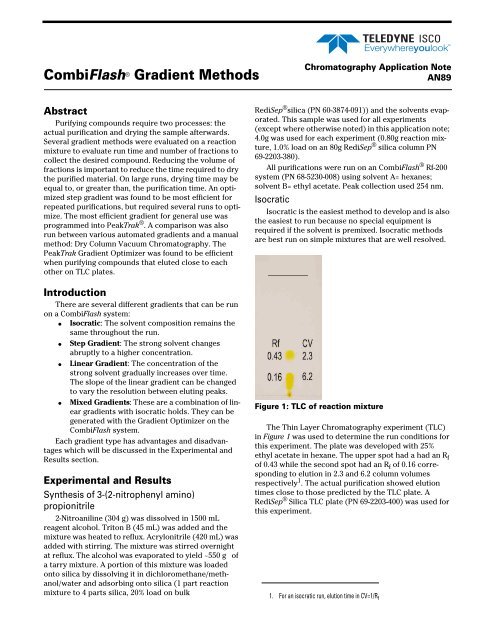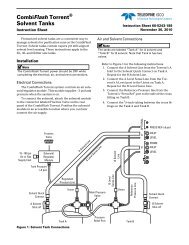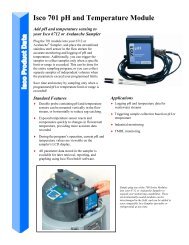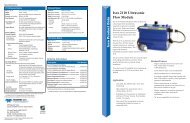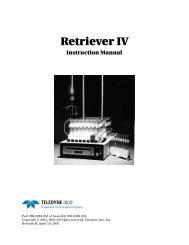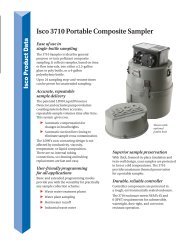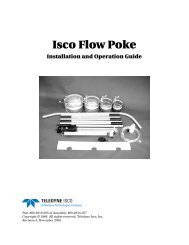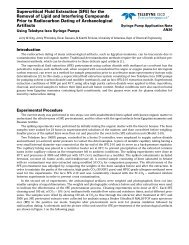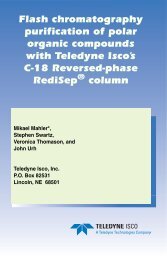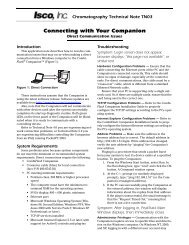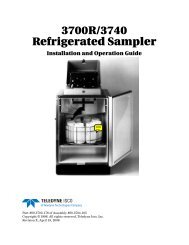AN89 CombiFlash Gradient Methods - Isco
AN89 CombiFlash Gradient Methods - Isco
AN89 CombiFlash Gradient Methods - Isco
You also want an ePaper? Increase the reach of your titles
YUMPU automatically turns print PDFs into web optimized ePapers that Google loves.
<strong>CombiFlash</strong> ® <strong>Gradient</strong> <strong>Methods</strong><br />
Chromatography Application Note<br />
<strong>AN89</strong><br />
Abstract<br />
Purifying compounds require two processes: the<br />
actual purification and drying the sample afterwards.<br />
Several gradient methods were evaluated on a reaction<br />
mixture to evaluate run time and number of fractions to<br />
collect the desired compound. Reducing the volume of<br />
fractions is important to reduce the time required to dry<br />
the purified material. On large runs, drying time may be<br />
equal to, or greater than, the purification time. An optimized<br />
step gradient was found to be most efficient for<br />
repeated purifications, but required several runs to optimize.<br />
The most efficient gradient for general use was<br />
programmed into PeakTrak ® . A comparison was also<br />
run between various automated gradients and a manual<br />
method: Dry Column Vacuum Chromatography. The<br />
PeakTrak <strong>Gradient</strong> Optimizer was found to be efficient<br />
when purifying compounds that eluted close to each<br />
other on TLC plates.<br />
Introduction<br />
There are several different gradients that can be run<br />
on a <strong>CombiFlash</strong> system:<br />
● Isocratic: The solvent composition remains the<br />
same throughout the run.<br />
● Step <strong>Gradient</strong>: The strong solvent changes<br />
abruptly to a higher concentration.<br />
● Linear <strong>Gradient</strong>: The concentration of the<br />
strong solvent gradually increases over time.<br />
The slope of the linear gradient can be changed<br />
to vary the resolution between eluting peaks.<br />
● Mixed <strong>Gradient</strong>s: These are a combination of linear<br />
gradients with isocratic holds. They can be<br />
generated with the <strong>Gradient</strong> Optimizer on the<br />
<strong>CombiFlash</strong> system.<br />
Each gradient type has advantages and disadvantages<br />
which will be discussed in the Experimental and<br />
Results section.<br />
Experimental and Results<br />
Synthesis of 3-(2-nitrophenyl amino)<br />
propionitrile<br />
2-Nitroaniline (304 g) was dissolved in 1500 mL<br />
reagent alcohol. Triton B (45 mL) was added and the<br />
mixture was heated to reflux. Acrylonitrile (420 mL) was<br />
added with stirring. The mixture was stirred overnight<br />
at reflux. The alcohol was evaporated to yield ~550 g of<br />
a tarry mixture. A portion of this mixture was loaded<br />
onto silica by dissolving it in dichloromethane/methanol/water<br />
and adsorbing onto silica (1 part reaction<br />
mixture to 4 parts silica, 20% load on bulk<br />
RediSep ® silica (PN 60-3874-091)) and the solvents evaporated.<br />
This sample was used for all experiments<br />
(except where otherwise noted) in this application note;<br />
4.0g was used for each experiment (0.80g reaction mixture,<br />
1.0% load on an 80g RediSep ® silica column PN<br />
69-2203-380).<br />
All purifications were run on an <strong>CombiFlash</strong> ® Rf-200<br />
system (PN 68-5230-008) using solvent A= hexanes;<br />
solvent B= ethyl acetate. Peak collection used 254 nm.<br />
Isocratic<br />
Isocratic is the easiest method to develop and is also<br />
the easiest to run because no special equipment is<br />
required if the solvent is premixed. Isocratic methods<br />
are best run on simple mixtures that are well resolved.<br />
Figure 1: TLC of reaction mixture<br />
The Thin Layer Chromatography experiment (TLC)<br />
in Figure 1 was used to determine the run conditions for<br />
this experiment. The plate was developed with 25%<br />
ethyl acetate in hexane. The upper spot had a had an R f<br />
of 0.43 while the second spot had an R f of 0.16 corresponding<br />
to elution in 2.3 and 6.2 column volumes<br />
respectively 1 . The actual purification showed elution<br />
times close to those predicted by the TLC plate. A<br />
RediSep ® Silica TLC plate (PN 69-2203-400) was used for<br />
this experiment.<br />
1. For an isocratic run, elution time in CV=1/R f
Chromatography Application Note <strong>AN89</strong><br />
Abs (254)<br />
1.2<br />
1.0<br />
0.8<br />
0.6<br />
0.4<br />
0.2<br />
0.0<br />
0 2 4 6 8 10 12 14<br />
Figure 2: Isocratic purification of 3-(2-nitrophenylamino)<br />
propionitrile<br />
The desired compound was completely eluted by 12<br />
column volumes. The first peak was collected in fraction<br />
totaling 125 mL solvent and the desired compound was<br />
collected in 500 mL solvent.<br />
Step <strong>Gradient</strong><br />
Time (CV)<br />
Desired<br />
Compound<br />
Step <strong>Gradient</strong>s can be very efficient, but require<br />
knowledge of the compound elution to be properly optimized.<br />
The TLC in Figure 1 indicated that the<br />
compounds are eluted 25% ethyl acetate. The run in<br />
Figure 2 shows there is a great deal of resolution<br />
between the two compounds.<br />
● Leaving the starting solvent at 25% B resolves<br />
the first peak from the small impurities eluting at<br />
1.5 CV.<br />
● Moving to 50% B allows the second peak to be<br />
eluted more quickly.<br />
100<br />
80<br />
60<br />
40<br />
20<br />
0<br />
Ethyl Acetate (%)<br />
The first peak was collected in 125 mL solvent. The<br />
second peak was collected in 225 mL solvent; ½ that for<br />
the isocratic experiment.<br />
A further optimization of the step gradient allows<br />
further reduction in run time and collected fractions.<br />
Changing the gradient from 50% to 100% B causes the<br />
second peak to elute within one column volume as the<br />
compound will no longer be retained by the column.<br />
This knowledge suggests the step be set at 2.6 column<br />
volumes, causing the second peak to elute as soon as<br />
the first peak finished eluting. With this optimization,<br />
the second peak is collected in only 75 mL solvent.<br />
Further optimizations can be made if the only concern<br />
is the purity of the second peak. In this case, the<br />
starting percentage of B can be increased to cause the<br />
first peak to elute more quickly. The step timing would<br />
need to be changed so that the elution of the second<br />
peak remains separate from the first peak while still<br />
resolving the desired compound from the impurities<br />
eluting at ~6.7 CV in Figure 4.<br />
Abs (254)<br />
3.0<br />
2.5<br />
2.0<br />
1.5<br />
1.0<br />
0.5<br />
Other<br />
Impurities<br />
0.0<br />
0 2 4 6 8 10 12 14<br />
Time (CV)<br />
100<br />
90<br />
80<br />
70<br />
60<br />
50<br />
40<br />
30<br />
20<br />
10<br />
0<br />
Ethyl Acetate (%)<br />
Abs (254 nm)<br />
2.5<br />
2.0<br />
1.5<br />
1.0<br />
0.5<br />
0.0<br />
0 2 4 6 8 10 12 14<br />
Time (CV)<br />
100<br />
90<br />
80<br />
70<br />
60<br />
50<br />
40<br />
30<br />
20<br />
10<br />
0<br />
Ethyl Acetate (%)<br />
Figure 4: Optimized step gradient<br />
These optimizations are best done in the context of<br />
repeated, large, purifications such as those found in a<br />
production setting.<br />
Shallow Linear <strong>Gradient</strong><br />
Users commonly run a TLC and set the gradient to<br />
center around the solvent concentration as run in Figure<br />
5.<br />
Figure 3: Step gradient purification
Chromatography Application Note <strong>AN89</strong><br />
Abs (254 nm)<br />
0.50<br />
0.45<br />
0.40<br />
0.35<br />
0.30<br />
0.25<br />
0.20<br />
0.15<br />
0.10<br />
0.05<br />
0.00<br />
0 5 10 15 20 25 30<br />
Figure 5: Purification of reaction products using a<br />
shallow gradient<br />
This gradient takes longer than using an isocratic<br />
elution at the solvent concentration used by the TLC.<br />
Compared to the run in Figure 2, the second peak takes<br />
longer to elute, and is collected in almost 50% more solvent,<br />
increasing the evaporation time by that amount.<br />
Default Linear <strong>Gradient</strong><br />
Time (CV)<br />
The Default Linear <strong>Gradient</strong> provided by <strong>CombiFlash</strong><br />
systems provides adequate resolution for most compounds.<br />
This gradient is useful for purifying natural<br />
products where the desired compound is not known.<br />
Medicinal chemists often use the default gradient to<br />
capture the minor compounds in addition to the desired<br />
reaction product.<br />
100<br />
90<br />
80<br />
70<br />
60<br />
50<br />
40<br />
30<br />
20<br />
10<br />
0<br />
Ethyl Acetate (%)<br />
For this gradient, the purification is complete before<br />
9 column volumes. The first peak was collected in 125<br />
mL solvent and the second was collected in 175 mL solvent.<br />
For this reaction mixture, these times compare<br />
favorably to the step gradient.<br />
<strong>Gradient</strong> Optimizer<br />
The <strong>Gradient</strong> Optimizer is a feature in PeakTrak that<br />
generates a gradient containing an isocratic hold. This<br />
method is useful when purifying compounds that elute<br />
closely, while minimizing the time required purifying the<br />
mixture. The gradient also allows all compounds to<br />
elute from the column. The <strong>Gradient</strong> Optimizer used two<br />
TLC runs to generate data to create the method. Compounds<br />
that are well resolved will be run with the<br />
standard gradient programmed into PeakTrak.<br />
For this experiment, a mixture of catechol and resorcinol<br />
was used because the reaction mixture used for<br />
the other experiments had sufficient resolution between<br />
the major compounds that the PeakTrak <strong>Gradient</strong> Optimizer<br />
used the default gradient.<br />
Catechol and resorcinol (50 g each) were dissolved<br />
in ethyl acetate and mixed with 400 g silica; sufficient<br />
ethyl acetate was added to make a slurry. The solvent<br />
was evaporated to make a dry, free-flowing powder. The<br />
mixture was allowed to “age” so that the purification<br />
was similar to that of an actual reaction.<br />
A mixture of catechol and resorcinol was run on TLC<br />
plates at 40% and 60% ethyl acetate in hexanes. These<br />
concentrations were chosen to elute the compounds of<br />
interest between R f values of 0.2 and 0.8 as per the<br />
instructions on the <strong>Gradient</strong> Optimizer software. The<br />
column was loaded with 14 g mixture (2.8g sample, 3.5%<br />
sample load).<br />
Solvent front: 7.80 cm<br />
Solvent front: 7.80 cm<br />
2.5<br />
100<br />
Abs (254)<br />
2.0<br />
1.5<br />
1.0<br />
80<br />
60<br />
40<br />
Ethyl Acetate (%)<br />
Rf<br />
0.40<br />
0.35<br />
Spot<br />
movement<br />
(cm)<br />
3.10<br />
2.81<br />
Rf<br />
0.54<br />
0.50<br />
Spot<br />
movement<br />
(cm)<br />
4.21<br />
3.90<br />
0.5<br />
20<br />
0.0<br />
0 2 4 6 8 10 12 14<br />
Time (CV)<br />
Figure 6: Reaction product eluted with standard<br />
<strong>CombiFlash</strong> gradient<br />
0<br />
Figure 7: TLC plates used for <strong>Gradient</strong> Optimizer<br />
data<br />
An 80g Rf silica column was loaded onto the<br />
<strong>CombiFlash</strong> system to load the basic parameters for the<br />
column such as flow rate. The TLC data was entered into
Chromatography Application Note <strong>AN89</strong><br />
the <strong>Gradient</strong> Optimizer (data for the first two eluting<br />
spots) and PeakTrak altered the method to allow the<br />
best purification for this method. The resulting chromatogram<br />
is shown in Figure 8.<br />
Abs (254 nm)<br />
Figure 8: <strong>Gradient</strong> Optimizer used to purify a<br />
complex mixture<br />
Abs (254 nm)<br />
0.7<br />
0.6<br />
0.5<br />
0.4<br />
0.3<br />
0.2<br />
0.1<br />
0.0<br />
0.7<br />
0.6<br />
0.5<br />
0.4<br />
0.3<br />
0.2<br />
0.1<br />
Desired<br />
Compound<br />
0 5 10 15 20 25<br />
Time (CV)<br />
Desired<br />
Compound<br />
0.0<br />
0 5 10 15<br />
Time (CV)<br />
Figure 9: Complex mixture purified with default<br />
gradient<br />
The <strong>Gradient</strong> Optimizer allowed better resolution of<br />
the desired compound and minimized run time.<br />
Dry Column Vacuum Chromatography<br />
Dry Column Vacuum Chromatography 2 is a technique<br />
considered, by some, to be superior to flash<br />
chromatography due to reduced diffusion. A typical<br />
experiment is to add ~1 column volume of solvent in<br />
increments of 5% or 10% B, drying the column between<br />
additions of solvent. The column drying is traditionally<br />
100<br />
80<br />
60<br />
40<br />
20<br />
0<br />
100<br />
80<br />
60<br />
40<br />
20<br />
0<br />
Ethyl Acetate (%)<br />
Ethyl Acetate (%)<br />
done with vacuum. Our modification used the air purge<br />
on an Rf-200 to blow the solvent out of the column.<br />
All experiments below used a 40g RediSep ® Rf silica<br />
column (PN 69-2203-340). The same sample (mixture of<br />
acetophenone, methyl paraben, and 4-aminobenzoic<br />
acid adsorbed on silica) was run for all experiments. Dry<br />
Column Vacuum Chromatography was compared to a<br />
run with the standard gradient used in PeakTrak, a<br />
stepped gradient approximating the steps for a Dry<br />
Vacuum Column Chromatography, and a Linear <strong>Gradient</strong><br />
over the same time. For the Dry Vacuum Column Chromatography<br />
experiment, software was written to control<br />
the pumps and the air purge through the column.<br />
Abs (254 nm)<br />
0.7<br />
0.6<br />
0.5<br />
0.4<br />
0.3<br />
0.2<br />
0.1<br />
0.0<br />
0<br />
0 2 4 6 8 10 12 14 16<br />
Time (CV)<br />
Figure 10: Standard PeakTrak gradient<br />
Abs (254 nm)<br />
0.50<br />
0.45<br />
0.40<br />
0.35<br />
0.30<br />
0.25<br />
0.20<br />
0.15<br />
0.10<br />
0.05<br />
0.00<br />
0 5 10 15 20<br />
Time (CV)<br />
Figure 11: Step <strong>Gradient</strong> approximating those for a<br />
Dry Vacuum Column Chromatography<br />
100<br />
80<br />
60<br />
40<br />
20<br />
100<br />
80<br />
60<br />
40<br />
20<br />
0<br />
Ethyl Acetate (%)<br />
Ethyl Acetate (%)<br />
2. Pedersen, D.S.; Rosenbohm, C. Synthesis 2001, No. 16, 2431-2434<br />
The peaks in Figure 11 are slightly wider, due to the<br />
gradient being longer. The peaks also show slightly later
Chromatography Application Note <strong>AN89</strong><br />
elution for the same reason. This is confirmed by the<br />
linear gradient over the same time range in Figure 12.<br />
the size of the steps and the air purge between each<br />
step.<br />
0.5<br />
100<br />
Table 1: Comparisons of various gradients to<br />
Dry Column Vacuum Chromatography (DCVC)<br />
Abs (254 nm)<br />
0.4<br />
0.3<br />
0.2<br />
0.1<br />
0.0<br />
0 5 10 15 20<br />
Time (CV)<br />
Figure 12: Linear <strong>Gradient</strong> over similar time range<br />
as Dry Vacuum Column Chromatography<br />
The Dry Column Vacuum Chromatography experiment<br />
required slightly longer than the others to elute all<br />
three peaks due to the time required to dry the column<br />
between steps. Peak widths are similar to those of the<br />
other runs, with the exception of the standard gradient<br />
which still shows narrower peaks.<br />
Abs (254 nm)<br />
1.0<br />
0.8<br />
0.6<br />
0.4<br />
0.2<br />
0.0<br />
0 5 10 15 20 25 30<br />
Time (Min)<br />
Figure 13: Dry Column Vacuum Chromatography<br />
sample run<br />
80<br />
60<br />
40<br />
20<br />
0<br />
Ethyl Acetate (%)<br />
Method<br />
Run<br />
Time<br />
Conclusions<br />
A<br />
Solvent<br />
Used<br />
B<br />
Solvent<br />
Used<br />
Total<br />
Solvent<br />
Used<br />
Standard 25 400 400 800<br />
5% Step<br />
<strong>Gradient</strong><br />
30 500 500 1000<br />
Extended<br />
Linear<br />
30 500 500 1000<br />
<strong>Gradient</strong><br />
DCVC 30 500 500 1000<br />
Table 2: Comparison of run times and<br />
collection volumes of various methods used<br />
to purify a reaction mixture<br />
<strong>Gradient</strong><br />
Method<br />
Peak 1<br />
Collected<br />
Volume<br />
(mL)<br />
Peak 2<br />
Collected<br />
Volume<br />
(mL)<br />
Elution<br />
Time (end<br />
of Peak 2,<br />
Column<br />
Volumes)<br />
Isocratic 125 500 12<br />
Step <strong>Gradient</strong><br />
(optimized)<br />
125 75 4.5<br />
Shallow <strong>Gradient</strong> 300 725 23<br />
Standard <strong>Gradient</strong> 125 175 9<br />
For compounds with good resolution, the optimized<br />
Step <strong>Gradient</strong> results in the fastest purification time and<br />
smallest collection volume. However, this required two<br />
runs to fully optimize the method making this method<br />
more suitable for repeated purifications of the same<br />
compounds. The next most efficient purification used<br />
the standard gradient programmed into PeakTrak. The<br />
standard gradient is useful for most research purposes.<br />
The <strong>Gradient</strong> Optimizer is best used for compounds that<br />
show reduced resolution on TLC plates. In all cases, TLC<br />
plates were used as a starting point to determine the<br />
correct method.<br />
Table 1 summarizes Dry Column Vacuum Chromatography;<br />
this experiment requires longer to run because of<br />
Teledyne <strong>Isco</strong><br />
P.O. Box 82531, Lincoln, Nebraska, 68501 USA<br />
Toll-free: (800) 228-4373 • Phone: (402) 464-0231 • Fax: (402) 465-3091<br />
E-mail: <strong>Isco</strong>Info@teledyne.com<br />
Teledyne <strong>Isco</strong> is continually improving its products and reserves the right to change product<br />
specifications, replacement parts, schematics, and instructions without notice.


